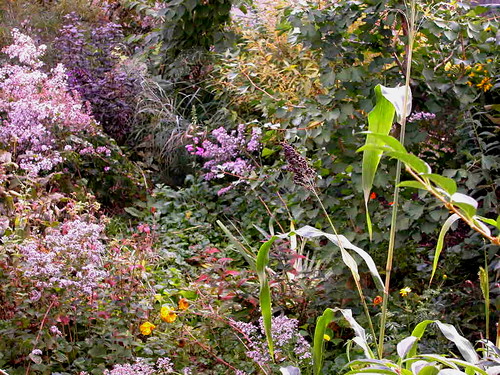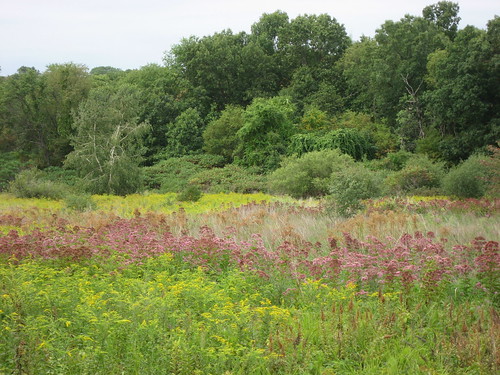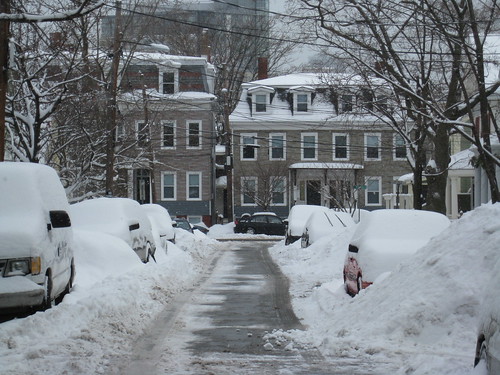Natural ecosystems also feature a wide variety of species. Biodiversity is the consequence of many niches that can be filled. Each plant, animal, fungus or bacteria has its own range of habitats that it can live in.
When there are fewer species in the landscape a single pest can wipe out all the greenery. For example, when I grew up in Chicago the streets were lined with the most wonderful elm trees. The elms formed a green tunnel--a canopy that reached across every street. It was wonderful, shady, quiet, and green. Until Dutch Elm Disease came to the midwest. Then every single tree on the block was killed within a matter of a year or two.
I took this picture in Medicine Hat, Alberta last summer. These are elms lining a street, giving you an idea of what most midwestern towns had about 40 or 50 years ago. I guess the disease hasn't taken a foothold in the climate of southern Alberta, which is consistently bitterly cold in the winter. Perhaps the beetle that carries the fungus that kills the elms can't live in this climate.
There's been a lot in the news lately about Rochester, New York and its ability to survive and thrive after the bankruptcy of Eastman Kodak. Economic experts attribute Rochester's survival to its diverse economy. Though Kodak failed, there are many other sources of economic vitality that keep the city afloat.
In a similar way, diverse communities can survive social, architectural, or economic trends that might otherwise ruin them. Consider our very diverse community of Cambridgeport, Massachusetts, where houses that are almost two centuries old live side to side with contemporary housing projects. Ironically our neighborhood is threatened by upward economic trends (high real estate values) that threaten to chase out poorer residents, artists, the elderly, and families, all of whom contribute to the vitality and diversity of this neighborhood.
How can designers and planners provide flexibility in their designs that will encourage diversity and long-term survival in their communities?





I think biodiversity is extremely important and therefore should definitely be expanded into other disciplines such as urban planning. From this article, I learned that the more diverse amount of species in an ecosystem the harder it is for the entire system to be wiped out by one particular thing. Therefore, the expansion of biodiversity will help preserve ecosystems and the specifies within them. The impact of buildings and diseases and other outside forces will still be present and may impact the ecosystem but hopefully not in a way where everything is wiped out.
ReplyDeleteIt is so interesting to me how one problem in biodiversity can wipe out an entire kind of plant, like the evergreen trees. Is there a way to prevent this from happening? I guess, according to what you said here, the species that carries the disease needs to be able to survive in that specific climate to spread it.
ReplyDeleteDiversity is always seen as a positive feature to any environment; yet, this post really shed light on the benefits of diversity in all areas of our lives. Just like different specie types benefit an ecosystem, diverse residents, architectural styles, and economic situations make a community more complex and, thus, more resistant to negative change. Homogeneousness seems synonymous to vulnerability.
ReplyDeletePreserving and increasing biodiversity is extremely important. And as you stated, it very well plays an active role in our community and therefore we need to somehow keep the diversity. I think with many building projects these days, builders and architects need to consider and implement ways to maximize the green in their plans and not only restore the diversity that is destroyed due to construction, but also add on to it.
ReplyDeleteAnother possibility, is to preserve those established buildings that contribute so much to their neighborhoods, by claiming them as landmarks therefore preventing them from being subject to rising home values and new construction.
In the perseverance of biodiversity is definitely very crucial to maintain the communities for animals and the plant itself. As more human interactions becomes more influential to many of the land areas, engineers should consider the value of plants and animals. It is essential that humans in general shall preserve the natural biodiversities on the planet itself since we are running out of natural resources. Thus, as architecture emerges into the communities, we think about preserving the natural "greens" to give a more diverse species of animals, insects, plants, and the natural community.
ReplyDelete-Lena Wang
The article is certainly very interesting to illustrate the importance of biodiversity. From a business perspective, the core of managing funds is to diversify, so if one account is compromised, the losses are not detrimental. The same idea goes for plants and animal species. However, it terms of urban planning, it is hard to diversify the designs of housing or the development of plant species due to cost. It is, regrettably, the underlining issue in every development. There are no communities that can sustain diseases or lack of resources forever. Conversely, there are few communities that cannot sustain any damage to their biological and social ecosystem. Although there is no immediate plan to solve this problem, it is indeed a fascinating topic and worth exploring.
ReplyDelete-Thomas Cui
Public policy is a dynamic field that constantly redefines itself. Even when a policy is seemingly in place and fairing well, (good) policymakers will continuously redefine the issue area in order to seek better and better alternatives for policy. As the ecosystem is constantly in flux, it only makes logical sense that biodiversity should play a greater role in policy planning. Direct effects are easily predicted when it comes to policy formation, but because we learned in class that only an estimated 10 percent of all biodiversity is known to science, that opens the door to a wide spectrum of indirect effects of our policies, structures, and activities. The problem is that it is difficult, if not impossible for me to conceptualize an architect, for example, integrating flexibility in his or her design once erected in the desired plot of land - so - the only solution I can come up with is an exponentially more rigorous planning process with input of various agencies, NGOs, and policy experts.
ReplyDelete-Gunita Singh
The only way to maintain biodiversity amongst all of the construction going on is to implement preserving plant life into building plans. If we do not take our natural surroundings into consideration, who knows what could happen in the future.
ReplyDelete-Liz Lauzon-
If you are able to put aside the costs for urban planing, I think it is a good idea to have a diversity in the planning of towns and neighborhoods. However, I did grow up going to a school that was off a street lined with cherry trees and I was reminded of that with the picture of the elm trees. While I think the diversity would help, and i haven't the slightest idea how to go about it, I think there is still something about having the same tree line the streets of a neighborhood.
ReplyDeleteI think that having a diverse and lush landscape filled with many different types of plants would not only be aesthetically appealing but would also do wonders for the environment! It seems like diversity is the key to ensuring that our ecosystems continue to thrive. It not only benefits all the animal and plant life, but also humans. I think we owe it to ourselves and to these other organisms to do our best to preserve nature and take into consideration our natural surroundings when we build a structure. In the long run, this could be extremely beneficial.
ReplyDeleteI think it is extremely important to expand the idea of biodiversity into something like urban planning. Humans are not going anywhere anytime soon so something must be done to make sure that biodiversity, as seen in the pictures above, does not become totally destroyed. The designers and planners must take into account the ecosystems that surround the places that they are trying to modernize. If they do not, places like Boston will begin to look more like your hometown in Chicago, without any trees.
ReplyDeleteAs biodiversity is essential to the environment, it is important for designers and planners to be sensitive to such an issue. To protect species variety, designers should try to create environmental friendly housing or sustainable architecture. They, moreover, could construct houses in areas that do not require massive deforestation. Although a prevention of further environmental damage is necessary, it is likewise vital to add to the existing biodiversity. Not only will this augment the amount of biodiversity, it would create a more aesthetic environment.
ReplyDeleteNatural Disaster in Uttrakhand India can be a lesson for whole world to save biodiversity and look only toward sustainable development. Infrastructure development, mining mineral resources, encroaching forest area, all needs stern regulation and moreover public awareness reagrding nature and natural conservation is most important.
ReplyDelete